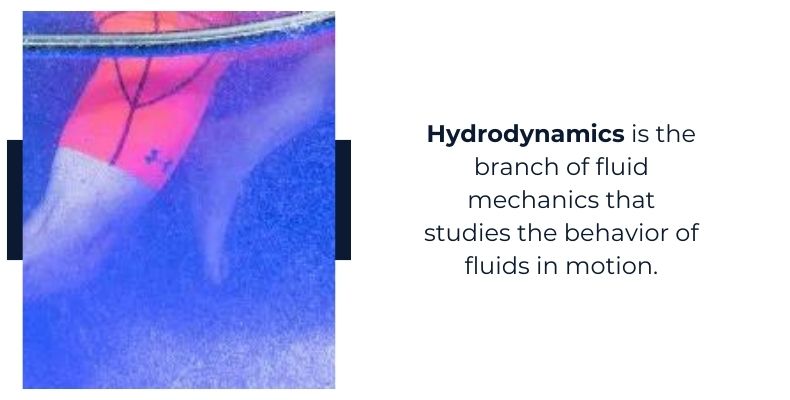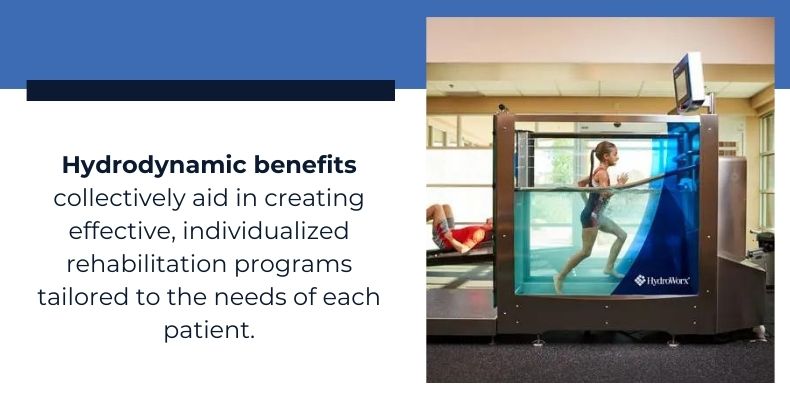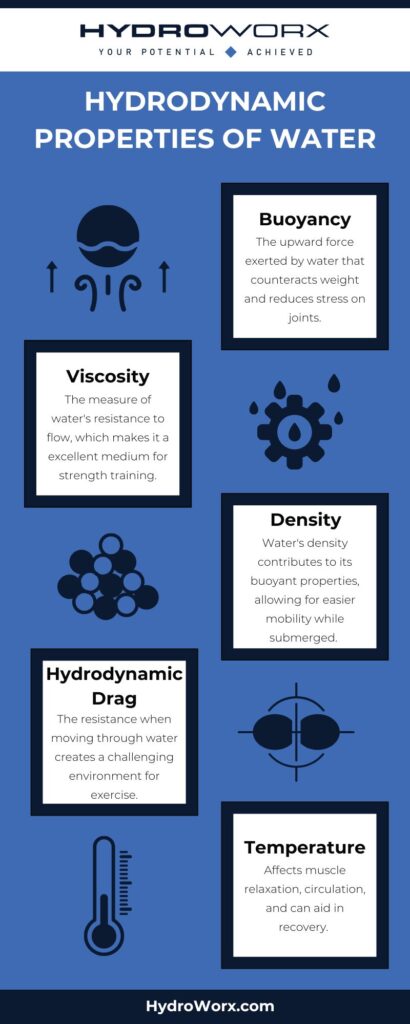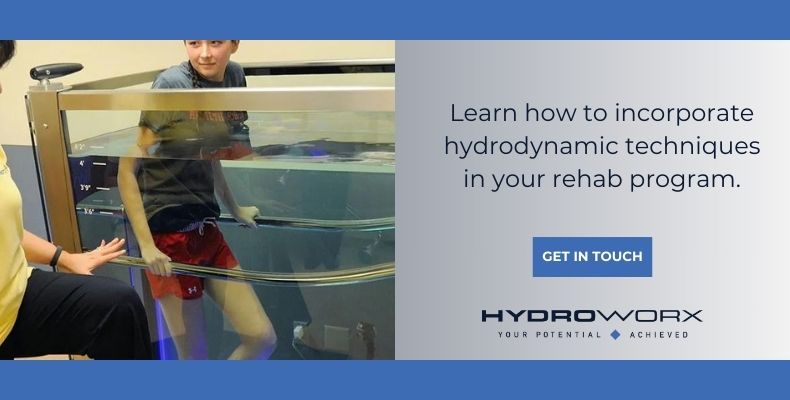The Role of Hydrodynamics in Aquatic Rehabilitation
Aquatic rehabilitation is a powerful tool for recovery, encompassing a range of therapies that utilize the unique properties of water. At the heart of this practice lies the role of hydrodynamics, the study of fluids in motion and their behavior. Understanding hydrodynamics is essential for therapists seeking to maximize the effectiveness of aquatic rehabilitation.
The principles of buoyancy, resistance, and flow dynamics all play a crucial role in shaping recovery strategies for individuals across various populations. By leveraging these properties, therapists can create customized rehabilitation programs that minimize joint stress, enhance muscle strength, and promote overall mobility. Whether for orthopedic recovery or stability training, the principles of hydrodynamics offer a scientifically grounded framework to optimize healing outcomes.
In this article from HyrdoWorx, we will explore the fundamental aspects of hydrodynamics, its benefits in rehabilitation, and techniques that utilize these principles.

Understanding Hydrodynamics
Hydrodynamics is the branch of fluid mechanics that studies the behavior of fluids in motion. In the context of aquatic rehabilitation, it focuses on how water’s unique properties, such as buoyancy, resistance, and flow, can be harnessed for therapeutic purposes. Understanding these principles is crucial for rehabilitation professionals as they design effective treatment plans.
- Buoyancy: This is the upward force exerted by water, which counteracts the weight of an object submerged in it. In rehabilitation, buoyancy helps support the body, significantly reducing the impact on joints and allowing patients to move more freely. This is especially beneficial for those recovering from injuries, surgeries, or chronic pain conditions.
- Resistance: Water provides natural resistance that can be adjusted based on the speed and intensity of movement. This resistance not only aids in building strength but also enhances cardiovascular endurance as patients work against the flow of water.
- Flow Dynamics: The movement of water itself can affect how exercises are performed. Understanding water currents and turbulence allows therapists to tailor exercises that optimize muscle engagement and recovery.
By grasping these fundamental concepts of hydrodynamics, rehabilitation specialists can better leverage aquatic environments to promote healing and recovery.

Benefits of Hydrodynamic Properties for Rehabilitation
Hydrodynamic properties in aquatic rehabilitation provide several significant advantages, making it an effective option for various patient populations. Here’s a breakdown of the key benefits:
Buoyancy:
- Reduces the impact on joints and muscles, allowing for safer movement.
- Supports individuals recovering from orthopedic surgeries or injuries, facilitating easier mobility.
Natural Resistance:
- Provides adjustable resistance as patients move through the water, enhancing strength training.
- Encourages cardiovascular fitness without the stress associated with land-based exercises.
Temperature Regulation:
- Warm water helps relax muscles and joints, promoting better blood circulation.
- Reduces muscle tension and alleviates pain, facilitating a more effective rehabilitation process.
Enhanced Proprioception:
- Water-based exercises improve body awareness and balance, which is essential for recovery.
- Encourages coordination through challenging movements in a supportive environment.
Low-Impact Environment:
- Offers a safer alternative for individuals with limited mobility or chronic pain.
- Allows patients to engage in physical activity sooner, promoting quicker recovery.
These hydrodynamic benefits collectively aid in creating effective, individualized rehabilitation programs tailored to the needs of each patient, ultimately promoting healing and improving functionality.

Techniques Utilizing Hydrodynamics in Therapy
Aquatic rehabilitation employs a variety of techniques that effectively harness hydrodynamics to optimize recovery for patients. Each method leverages the unique properties of water, allowing therapists to design tailored rehabilitation programs. Here are some of the most commonly used techniques:
- Underwater Treadmill Therapy: This method involves using a submerged treadmill, where patients walk or run against the resistance of water. The buoyancy reduces stress on joints, making it an ideal option for individuals recovering from surgeries or injuries. Therapists can adjust the water depth and underwater treadmill speed to match the patient’s fitness level and rehabilitation goals.
- Aquatic Resistance Training: Patients perform specific strength-training exercises in water, utilizing its natural resistance. By maneuvering against the water flow, individuals can target particular muscle groups effectively, promoting strength gains without the risk of injury associated with traditional weight training.
- Swimming: This versatile exercise allows patients to engage in various strokes to improve cardiovascular fitness, strength, and flexibility. Swimming’s low-impact nature makes it suitable for individuals of all ages and fitness levels, enhancing overall conditioning while minimizing stress on the body.
- Hydrotherapy Pools: Specialized hydrotherapy pools may include jets and adjustable currents, allowing therapists to create customized resistance settings. Patients can perform exercises that mimic land-based movements while benefiting from the supportive water environment.
- Aquatic Stretching: Water-based stretching techniques help improve flexibility and range of motion. The buoyancy provides support during stretching exercises, allowing patients to reach positions that may be challenging on land.
By integrating these techniques into rehabilitation programs, therapists can tailor treatments to individual needs, enhancing healing while promoting mobility and strength in a safe, supportive environment.

Unlock the Full Potential of Aquatic Rehabilitation With Hydrodynamics
Whether you’re a therapist or a caregiver, understanding how to effectively utilize water’s unique properties can transform recovery programs. Advanced techniques such as underwater treadmill therapy, resistance training, and hydrotherapy can enhance strength, flexibility, and overall functional ability while minimizing the risk of injury.
Don’t miss the opportunity to incorporate these innovative strategies into your practice. Contact us today to learn more about how to integrate hydrodynamic techniques into your rehabilitation programs and provide the best possible care for your patients. Explore our resources, and discover how HydroWorx hydrotherapy equipment can elevate your aquatic therapy offerings. Start your journey toward enhanced recovery and improved outcomes — get in touch with us now!

